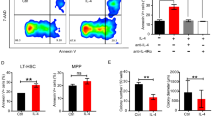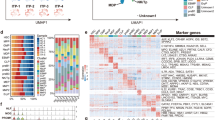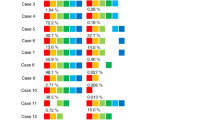Abstract
The pathophysiology of the myelodysplastic syndromes (MDS) is incompletely understood. Tumor necrosis factor (TNF)α levels are elevated, particularly in early-stage MDS, and apoptosis in marrow cells is upregulated. Observations in other models have shown a role for insulin-like growth factor binding protein 3 (IGFBP-3) in TNFα-mediated apoptosis. We observed increased levels of IGFBP-3 in the marrow plasma of patients with MDS (P=0.005) and hypothesized that altered IGFBP-3 levels contribute to the dysregulation of hemopoiesis in MDS by affecting proliferation and apoptosis. Western analysis of marrow plasma from MDS patients revealed an increase in the ratio of intact vs fragmented IGFBP-3 in early-stage MDS (relative to controls) that decreased with MDS disease progression, suggesting increased proteolysis with more advanced disease. Thus, these results provide evidence for dysregulation of IGFBP-3 in patients with MDS. While the data are complex, they are consistent with a modulatory effect of IGFBP-3 on hemopoiesis in MDS. Conceivably, understanding these mechanisms may allow for the development of novel therapeutic strategies.
This is a preview of subscription content, access via your institution
Access options
Subscribe to this journal
Receive 12 print issues and online access
$259.00 per year
only $21.58 per issue
Buy this article
- Purchase on Springer Link
- Instant access to full article PDF
Prices may be subject to local taxes which are calculated during checkout




Similar content being viewed by others
References
Hellstrom-Lindberg E, Negrin R, Stein R, Krantz S, Lindberg G, Vardiman J et al. Erythroid response to treatment with G-CSF plus erythropoietin for the anaemia of patients with myelodysplastic syndromes: proposal for a predictive model. Br J Haematol 1997; 99: 344–351.
Hirai H . Molecular mechanisms of myelodysplastic syndrome. Jpn J Clin Oncol 2003; 33: 153–160.
Gersuk GM, Beckham C, Loken MR, Kiener P, Anderson JE, Farrand A et al. A role for tumour necrosis factor-alpha, Fas and Fas-ligand in marrow failure associated with myelodysplastic syndrome. Br J Haematol 1998; 103: 176–188.
Rajah R, Lee KW, Cohen P . Insulin-like growth factor binding protein-3 mediates tumor necrosis factor-alpha-induced apoptosis: role of Bcl-2 phosphorylation. Cell Growth Differ 2002; 13: 163–171.
Lackey BR, Gray SL, Henricks DM . The insulin-like growth factor (IGF) system and gonadotropin regulation: actions and interactions. Cytokine Growth Factor Rev 1999; 10: 201–217.
Samani AA, Brodt P . The receptor for the type I insulin-like growth factor and its ligands regulate multiple cellular functions that impact on metastasis. Surg Oncol Clin N Am 2001; 10: 289–312, viii.
Butt AJ, Firth SM, Baxter RC . The IGF axis and programmed cell death. Immunol Cell Biol 1999; 77: 256–262, (review).
Nickerson T, Huynh H, Pollak M . Insulin-like growth factor binding protein-3 induces apoptosis in MCF7 breast cancer cells. Biochem Biophys Res Commun 1997; 237: 690–693, (Erratum in: Biochem Biophys Res Commun 1997; 240:246).
Fowler CA, Perks CM, Newcomb PV, Savage PB, Farndon JR, Holly JM . Insulin-like growth factor binding protein-3 (IGFBP-3) potentiates paclitaxel-induced apoptosis in human breast cancer cells. Int J Cancer 2000; 88: 448–453.
Perks CM, McCaig C, Holly JM . Differential insulin-like growth factor (IGF)-independent interactions of IGF binding protein-3 and IGF binding protein-5 on apoptosis in human breast cancer cells. Involvement of the mitochondria. J Cell Biochem 2000; 80: 248–258.
Yu H, Rohan T . Role of the insulin-like growth factor family in cancer development and progression. J Natl Cancer Inst 2000; 92: 1472–1489.
Maile LA, Gill ZP, Perks CM, Holly JM . The role of cell surface attachment and proteolysis in the insulin-like growth factor (IGF)-independent effects of IGF-binding protein-3 on apoptosis in breast epithelial cells. Endocrinology 1999; 140: 4040–4045.
Angelloz-Nicoud P, Lalou C, Binoux M . Prostate carcinoma (PC-3) cell proliferation is stimulated by the 22–25-kDa proteolytic fragment (1–160) and inhibited by the 16-kDa fragment (1–95) of recombinant human insulin-like growth factor binding protein-3. Growth Horm IGF Res 1998; 8: 71–75.
Loechel F, Fox JW, Murphy G, Albrechtsen R, Wewer UM . ADAM 12-S cleaves IGFBP-3 and IGFBP-5 and is inhibited by TIMP-3. Biochem Biophys Res Commun 2000; 278: 511–515, (Erratum in: Biochem Biophys Res Commun 2001; 280: 421.
Schedlich LJ, Nilsen T, John AP, Jans DA, Baxter RC . Phosphorylation of insulin-like growth factor binding protein-3 by deoxyribonucleic acid-dependent protein kinase reduces ligand binding and enhances nuclear accumulation. Endocrinology 2003; 144: 1984–1993.
Longobardi L, Torello M, Buckway C, O'Rear L, Horton WA, Hwa V et al. A novel insulin-like growth factor (IGF)-independent role for IGF binding protein-3 in mesenchymal chondroprogenitor cell apoptosis. Endocrinology 2003; 144: 1695–1702.
McCaig C, Perks CM, Holly JM . Intrinsic actions of IGFBP-3 and IGFBP-5 on Hs578T breast cancer epithelial cells: inhibition or accentuation of attachment and survival is dependent upon the presence of fibronectin. J Cell Sci 2002; 115 (Part 22): 4293–4303.
Grigoriev VG, Moerman EJ, Goldstein S . Overexpression of insulin-like growth factor binding protein-3 by senescent human fibroblasts: attenuation of the mitogenic response to IGF-I. Exp Cell Res 1995; 219: 315–321.
Grigoriev VG, Moerman EJ, Goldstein S . Senescence and cell density of human diploid fibroblasts influence metabolism of insulin-like growth factor binding proteins. J Cell Physiol 1994; 160: 203–211.
Goldstein S, Moerman EJ, Baxter RC . Accumulation of insulin-like growth factor binding protein-3 in conditioned medium of human fibroblasts increases with chronologic age of donor and senescence in vitro. J Cell Physiol 1993; 156: 294–302.
Goldstein S, Moerman EJ, Jones RA, Baxter RC . Insulin-like growth factor binding protein 3 accumulates to high levels in culture medium of senescent and quiescent human fibroblasts. Proc Natl Acad Sci USA 1991; 88: 9680–9684.
Matsunaga H, Handa JT, Gelfman CM, Hjelmeland LM . The mRNA phenotype of a human RPE cell line at replicative senescence. Mol Vis 1999; 5: 39.
Arnold PM, Ma JY, Citron BA, Festoff BW . Insulin-like growth factor binding proteins in cerebrospinal fluid during human development and aging. Biochem Biophys Res Commun 1999; 264: 652–656.
Perks CM, Holly JMP . Insulin-like growth factor binding proteins (IGFBPs) in breast cancer. J Mamm Gland Biol Neoplasia 2000; 5: 75–84.
Ferry Jr RJ, Katz LE, Grimberg A, Cohen P, Weinzimer SA . Cellular actions of insulin-like growth factor binding proteins. Horm Metab Res 1999; 31: 192–202.
Baxter RC . Signalling pathways involved in antiproliferative effects of IGFBP-3: a review. Mol Pathol 2001; 54: 145–148.
Baxter RC . Insulin-like growth factor (IGF)-binding proteins: interactions with IGFs and intrinsic bioactivities. Am J Physiol Endocrinol Metab 2000; 278: E967–E976.
Steensma DP, Tefferi A . The myelodysplatic syndrome(s): a perspective and review highlighting current controversies. Leukemia Res 2003; 27: 95–120.
Vergilio JA, Bagg A . Myelodysplastic syndromes. Contemporary biologic concepts and emerging diagnostic approaches. Am J Con Pathol 2003; 119 (Suppl): S58–S77.
Deeg HJ, Beckham C, Loken MR, Bryant E, Lesnikova M, Shulman HM et al. Negative regulators of hemopoiesis and stroma function in patients with myelodysplastic syndrome. Leukemia Lymphoma 2000; 37: 405–414.
Roecklein BA, Torok-Storb B . Functionally distinct human marrow stromal cell lines immortalized by transduction with the human papilloma virus E6/E7 genes. Blood 1995; 85: 997–1005.
Wilson HM, Birnbaum RS, Poot M, Quinn LS, Swisshelm K . Insulin-like growth factor binding protein-related protein 1 inhibits proliferation of MCF-7 breast cancer cells via a senescence-like mechanism. Cell Growth Differ 2002; 13: 205–213.
Platzbecker U, Ward JL, Deeg HJ . Chelerythrin activates caspase-8, downregulates FLIP long and short, and overcomes resistance to tumour necrosis factor-related apoptosis-inducing ligand in KG1a cells. Br J Haematol 2003; 122: 489–497.
Gill ZP, Perks CM, Newcomb PV, Holly JM . Insulin-like growth factor-binding protein (IGFBP-3) predisposes breast cancer cells to programmed cell death in a non-IGF-dependent manner. J Biol Chem 1997; 272: 25602–25607.
Bagnall W, Sharpe PM, Newham P, Tart J, Mott RA, Torr VR et al. Expression and purification of biologically active IGF-binding proteins using the LCR/Mel expression system. Protein Expr Purif 2003; 27: 1–11.
Nusrat AR, Chapman Jr HA . An autocrine role for urokinase in phorbol ester-mediated differentiation of myeloid cell lines. J Clin Invest 1991; 87: 1091–1097.
Firth SM, McDougall F, McLachlan AJ, Baxter RC . Impaired blockade of insulin-like growth factor I (IGF-I)-induced hypoglycemia by IGF binding protein-3 analog with reduced ternary complex-forming ability. Endocrinology 2002; 143: 1669–1676.
Firth SM, Baxter RC . Characterisation of recombinant glycosylation variants of insulin-like growth factor binding protein-3. J Endocrinol 1999; 160: 379–387.
Sivan B, Lilos P, Laron Z . Effects of insulin-like growth factor-I deficiency and replacement therapy on the hematopoietic system in patients with Laron syndrome (primary growth hormone insensitivity). J Pediatr Endocrinol Metab 2003; 16: 509–520.
Miyagawa S, Kobayashi M, Konishi N, Sato T, Ueda K . Insulin and insulin-like growth factor I support the proliferation of erythroid progenitor cells in bone marrow through the sharing of receptors. Br J Haematol 2000; 109: 555–562.
Ikezoe T, Tanosaki S, Krug U, Liu B, Cohen P, Taguchi H et al. Insulin-like growth factor binding protein-3 antagonizes the effects of retinoids in myeloid leukemia cells. Blood 2004; 104: 237–242.
Schedlich LJ, Graham LD . Role of insulin-like growth factor binding protein-3 in breast cancer cell growth. Microsc Res Technol 2002; 59: 12–22.
Acknowledgements
We thank Dr Deborah Banker for providing the ML-1 and KG1a cell lines and Dr Beverly Torok-Storb for providing the HS-5 stroma cell line. We also thank Dr Yansong Gu, Dr Uwe Platzbecker, Dr Jeffrey Schwartz, Dr Martin Benesch, and Cassandra Beckham for helpful discussions. We thank Kathleen Haugk for immunoblot analysis of phosphorylated IGF receptor in ML-1 cells. This work was supported by PHS Grant CA87948 and HL36444 Grant.
Author information
Authors and Affiliations
Corresponding author
Rights and permissions
About this article
Cite this article
Wilson, HM., Lesnikov, V., Plymate, S. et al. High IGFBP-3 levels in marrow plasma in early-stage MDS: effects on apoptosis and hemopoiesis. Leukemia 19, 580–585 (2005). https://doi.org/10.1038/sj.leu.2403672
Received:
Accepted:
Published:
Issue Date:
DOI: https://doi.org/10.1038/sj.leu.2403672
Keywords
This article is cited by
-
Immune-Related Antigens, Surface Molecules and Regulatory Factors in Human-Derived Mesenchymal Stromal Cells: The Expression and Impact of Inflammatory Priming
Stem Cell Reviews and Reports (2012)
-
Frequent elevation of Akt kinase phosphorylation in blood marrow and peripheral blood mononuclear cells from high-risk myelodysplastic syndrome patients
Leukemia (2006)
-
Chimerism and outcomes after allogeneic hematopoietic cell transplantation following nonmyeloablative conditioning
Leukemia (2006)



